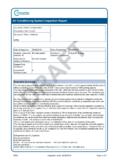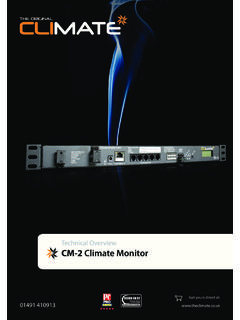Transcription of Digilent Pmod Interface Specification
1 DDiiggiilleenntt PPmmoodd IInntteerrffaaccee SSppeecciiffiiccaattiioonn Revision: November 20, 2011 1300 NE henley Court, Suite 3 Pullman, WA 99163 (509) 334 6306 Voice | (509) 334 6300 Fax Doc: 510-002 page 1 of 11 Copyright Digilent , Inc. All rights reserved. Other product and company names mentioned may be trademarks of their respective owners. Introduction The Digilent Pmod Interface is used to connect low frequency, low I/O pin count peripheral modules to host controller boards. There are six-pin and twelve-pin versions of the Interface defined. The six-pin version provides four digital I/O signal pins, one power pin and one ground pin. The twelve-pin version provides eight I/O signal pins, two power pins and two ground pins. The signals of the twelve-pin version are arranged so that it provides two of the six-pin interfaces stacked. In general, Pmod peripheral modules can plug directly into connectors on the host controller board, or be connected to the controller board via six-pin or twelve-pin cables.
2 Two six-pin peripheral modules can be connected to a single twelve-pin host connector via a twelve-pin to dual six-pin splitter cable. Similarly, a single twelve-pin peripheral module can be connected to two six-pin host connectors via the same twelve-pin to dual six-pin splitter cable. Pmod peripheral modules are powered by the host via the Interface s power and ground pins. The Pmod Interface is not intended for high frequency operation, however, using RJ45 connectors and twisted pair Ethernet cable, signals have been sent reliably at 24 Mhz and distances of up to 4 meters. In addition to the six and twelve pin interfaces, the Pmod peripheral module Interface also encompasses a variant using the I2C Interface , and two or four wire MTE cables. In some cases, an I2C connected module can be connected directly to a Pmod connector on a system board, but generally the connection will be via MTE cables. The Pmod I2C Interface provides the two I2C signals, SDA and SCL, plus power and ground.
3 Electrical Specifications The digital signal characteristics are not specified. However, the general expectation is that a logic power supply will be used and the signals will conform to LVCMOS or LVTTL logic conventions. The driver current source/sink capability isn t specified and depends on the capabilities of the specific system board or module. The I/O pins on the system board are generally directly driven by the FPGA or microcontroller. The I/O pins on Xilinx FPGAs generally have symmetrical 24mA source/sink capability. The drive capability of microcontrollers is generally less and some of them are not symmetrical. The drive strength for microcontroller pins is generally in the range +/-5mA to +/-10mA. The I/O pins on system board Pmod connectors generally have ESD protection diodes and 200ohm series resistors. The resistors are to limit short circuit currents if pins are inadvertently shorted, or to protect against driver conflicts if outputs are inadvertently connected together.
4 Peripheral modules may be connected to the host via cables of up to 18 in length. The drivers on the host or peripheral module should have sufficient drive strength to drive this length of cable at Digilent Pmod Interface Specification page 2 of 11 Copyright Digilent , Inc. All rights reserved. Other product and company names mentioned may be trademarks of their respective owners. whatever the operating speed of the Interface on the Pmod is expected to be. In general, this means that the driver should be able to source or sink at least 5mA of current. Peripheral modules may not assume that pull-up or pull-down resistors are present on the host and must provide for proper termination of inputs, if necessary, and may not use open drain or open collector outputs, unless the pull-up is provided on the peripheral module itself. For I2C connected modules, the digital signal characteristics conform to the I2C Specification .
5 Either 5V or levels can be used on most modules, but Digilent system boards operate at , and the modules are primarily intended for operation at The driver current sink capability isn t specified and depends on the capabilities of the specific system board or module. The I/O pins on the system board are generally directly driven by the FPGA or microcontroller. The I/O pins on Xilinx FPGAs generally have symmetrical 24mA source/sink capability. The drive capability of microcontrollers is generally less and some of them are not symmetrical. The I2C bus is an open collector bus. The pull-up resistors used to provide the logic high level are not provided on the modules and therefore must be provided on the system board. Some Digilent system boards use current mirrors rather than simple pull-up resistors to provide the logic high level to allow driving longer busses with greater capacitive load. Microcontroller system boards are generally provided with dedicated I2C connectors and provide pull-up resistors that are jumper selectable to be in or out of circuit.
6 FPGA based system boards generally do not provide dedicated I2C connectors, and depend on the internal pull-up resistors in the FPGA I/O blocks to provide the pull-ups. Power Supply The power pins of the Interface provide power from the host to the peripheral. The complete Interface requires that the host provide the ability to switch the voltage on the power pins between and A reduced functionality subset of the spec. allows the host to provide only at the power supply pins, with no ability to switch. On the twelve-pin version of the Interface , both power supply pins switch together and always supply the same voltage. These pins may be shorted together at either the host end or the peripheral end. On I2C connected modules, the power pins of the Interface provide power from the system board to the peripheral module. The supplied voltage will generally be , but operation at 5V is supported by some modules.
7 The connector on the modules provides two sets of the I2C signals and the power and ground pins to allow daisy chaining multiple modules onto the bus. The two power pins and the two ground pins may be shorted together respectively at either the system board end or the peripheral module end of the connection. The amount of power a peripheral module is allowed to draw from the host is not specified, but should not be assumed to be more than approximately 100mA. Digilent Pmod Interface Specification page 3 of 11 Copyright Digilent , Inc. All rights reserved. Other product and company names mentioned may be trademarks of their respective owners. Physical Connection Standard Pmod connections are made using standard 100mil spaced, 25mil square, pin-header style connectors. The peripheral module board will have a male connector. This will typically be a right angle connector, at the board edge, for direct connection to a host board, This can be a straight male connector inboard from the board edge if only cable connections will be used.
8 The host board will typically have a right angle female connector at the board edge for direct connection of peripheral module boards. This connector can be a straight male connector inboard from the board edge if only cable connections will be used. When multiple connectors are placed side-by-side along a board edge (either host or peripheral), the connectors are spaced , center-to-center. This allows for wide modules to be plugged side-by-side into a host without interference. Peripheral modules with multiple connectors must also have them spaced on centers for direct connection to a host. Peripheral modules with a single connector that are intended for direct connection to a host, or that are intended to fit into the Pmod mounting clip, should be wide. There should also be >25mil of clearance from the board edge to any components to allow clearance for the Pmod clip to latch the board edge.
9 The connector should be centered along the side of the module. Peripheral modules that are more than wide can be directly connected to a host in some cases but may interfere with adjacent connectors on the host. The following diagrams show physical connector placement and pin numbering conventions for the host (system board) and peripheral module sides of the connection. Note that the pin numbering conventions for the 2x6 connectors are non-standard and are mirrored between the host connector and the peripheral board connector. " "Right angle femaleconnectorRight angle maleconnectorFig 1: Standard Six-Pin Connector Placement Digilent Pmod Interface Specification page 4 of 11 Copyright Digilent , Inc. All rights reserved. Other product and company names mentioned may be trademarks of their respective owners. " "Right angle femaleconnectorRight angle maleconnectorFig 2: Standard Twelve-Pin Connector Placement789101112789101112 The connection standard for system boards that provide I2C connectors is to use a 2x4 male, 100 mil spaced, pin header connector with straight pins.
10 This connector is generally not near a board edge, as the intent is to use cable connections rather than directly plugging the module into the connector. The connector provides two sets of the I2C signals, power and ground, so that the I2C bus can be formed by daisy chaining system boards or Pmods. The system board can either be the root of one or two daisy chains, or in the middle of a daisy chain. Pmods with I2C interfaces will also have a 2x4 pin header connector so that the module can be included in a daisy chain of modules and system boards. The I2C connector can either be a right angle male connector at the board edge if reason to restrict overall module height or a straight male connector anywhere on the board if there is no reason to restrict module height. Some modules have both an SPI and an I2C Interface . In this case the SPI Interface will appear on a 2x6 right angle male connector conforming to the above placement conventions, and the I2C Interface will appear on a 2x4 straight male connector inboard from the board edge.







